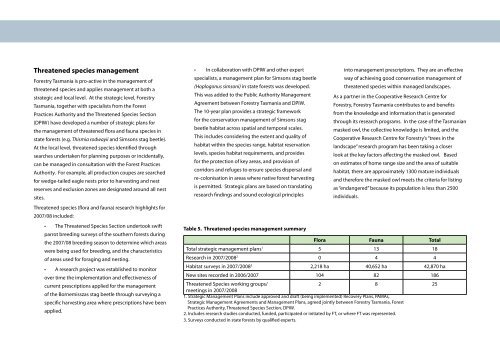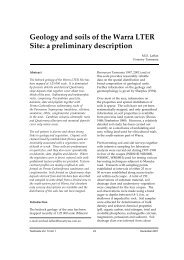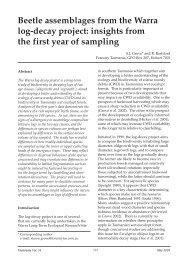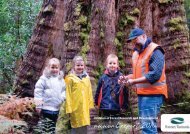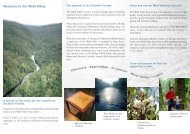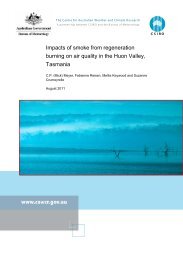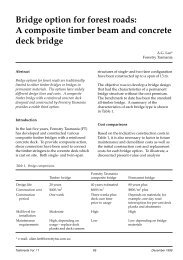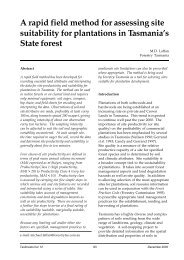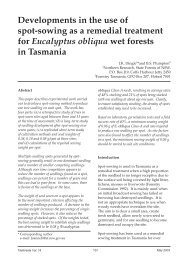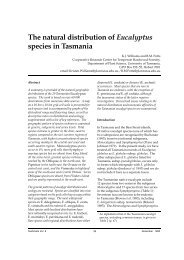sustainable forest management - Forestry Tasmania
sustainable forest management - Forestry Tasmania
sustainable forest management - Forestry Tasmania
You also want an ePaper? Increase the reach of your titles
YUMPU automatically turns print PDFs into web optimized ePapers that Google loves.
Threatened species <strong>management</strong><br />
<strong>Forestry</strong> <strong>Tasmania</strong> is pro-active in the <strong>management</strong> of<br />
threatened species and applies <strong>management</strong> at both a<br />
strategic and local level. At the strategic level, <strong>Forestry</strong><br />
<strong>Tasmania</strong>, together with specialists from the Forest<br />
Practices Authority and the Threatened Species Section<br />
(DPIW) have developed a number of strategic plans for<br />
the <strong>management</strong> of threatened flora and fauna species in<br />
state <strong>forest</strong>s (e.g. Thismia rodwayii and Simsons stag beetle).<br />
At the local level, threatened species identified through<br />
searches undertaken for planning purposes or incidentally,<br />
can be managed in consultation with the Forest Practices<br />
Authority. For example, all production coupes are searched<br />
for wedge-tailed eagle nests prior to harvesting and nest<br />
reserves and exclusion zones are designated around all nest<br />
sites.<br />
Threatened species (flora and fauna) research highlights for<br />
2007/08 included:<br />
• The Threatened Species Section undertook swift<br />
parrot breeding surveys of the southern <strong>forest</strong>s during<br />
the 2007/08 breeding season to determine which areas<br />
were being used for breeding, and the characteristics<br />
of areas used for foraging and nesting.<br />
• A research project was established to monitor<br />
over time the implementation and effectiveness of<br />
current prescriptions applied for the <strong>management</strong><br />
of the Bornemisszas stag beetle through surveying a<br />
specific harvesting area where prescriptions have been<br />
applied.<br />
• In collaboration with DPIW and other expert<br />
specialists, a <strong>management</strong> plan for Simsons stag beetle<br />
(Hoplogonus simsoni) in state <strong>forest</strong>s was developed.<br />
This was added to the Public Authority Management<br />
Agreement between <strong>Forestry</strong> <strong>Tasmania</strong> and DPIW.<br />
The 10-year plan provides a strategic framework<br />
for the conservation <strong>management</strong> of Simsons stag<br />
beetle habitat across spatial and temporal scales.<br />
This includes considering the extent and quality of<br />
habitat within the species range, habitat reservation<br />
levels, species habitat requirements, and provides<br />
for the protection of key areas, and provision of<br />
corridors and refuges to ensure species dispersal and<br />
re-colonisation in areas where native <strong>forest</strong> harvesting<br />
is permitted. Strategic plans are based on translating<br />
research findings and sound ecological principles<br />
Table 5. Threatened species <strong>management</strong> summary<br />
into <strong>management</strong> prescriptions. They are an effective<br />
way of achieving good conservation <strong>management</strong> of<br />
threatened species within managed landscapes.<br />
As a partner in the Cooperative Research Centre for<br />
<strong>Forestry</strong>, <strong>Forestry</strong> <strong>Tasmania</strong> contributes to and benefits<br />
from the knowledge and information that is generated<br />
through its research programs. In the case of the <strong>Tasmania</strong>n<br />
masked owl, the collective knowledge is limited, and the<br />
Cooperative Research Centre for <strong>Forestry</strong>’s “trees in the<br />
landscape” research program has been taking a closer<br />
look at the key factors affecting the masked owl. Based<br />
on estimates of home range size and the area of suitable<br />
habitat, there are approximately 1300 mature individuals<br />
and therefore the masked owl meets the criteria for listing<br />
as “endangered” because its population is less than 2500<br />
individuals.<br />
Flora Fauna Total<br />
Total strategic <strong>management</strong> plans 1 5 13 18<br />
Research in 2007/2008 2 0 4 4<br />
Habitat surveys in 2007/2008 3 2,218 ha 40,652 ha 42,870 ha<br />
New sites recorded in 2006/2007 104 82 186<br />
Threatened Species working groups/<br />
2 8 25<br />
meetings in 2007/2008<br />
1. Strategic Management Plans include approved and draft (being implemented) Recovery Plans, PAMAs,<br />
Strategic Management Agreements and Management Plans, agreed jointly between <strong>Forestry</strong> <strong>Tasmania</strong>, Forest<br />
Practices Authority, Threatened Species Section, DPIW.<br />
2. Includes research studies conducted, funded, participated or initiated by FT, or where FT was represented.<br />
3. Surveys conducted in state <strong>forest</strong>s by qualified experts.


